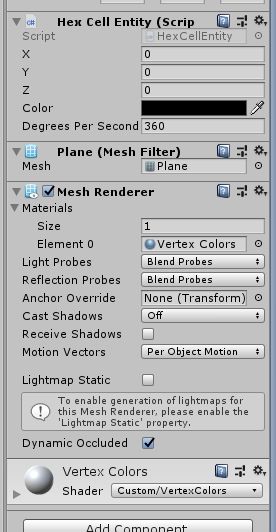用ECS做HexMap:自动生成地图系统
基于Unity2019最新ECS架构开发MMO游戏笔记16
- 自动生成地图系统
- AutoCreateMapSystem
- 神奇的六边形
- 六边形实体
- 创建者和创建六边形单元系统
- 更新计划
- 作者的话
- ECS系列目录
- ECS官方示例1:ForEach
- ECS官方案例2:IJobForEach
- ECS官方案例3:IJobChunk
- ECS官方案例4:SubScene
- ECS官方案例5:SpawnFromMonoBehaviour
- ECS官方案例6:SpawnFromEntity
- ECS官方案例7:SpawnAndRemove
- ECS进阶:FixedTimestepWorkaround
- ECS进阶:Boids
- ECS进阶:场景切换器
- ECS进阶:MegaCity0
- ECS进阶:MegaCity1
- UnityMMO资源整合&服务器部署
- UnityMMO选人流程
- UnityMMO主世界
- UnityMMO网络同步
- 用ECS做HexMap:自动生成地图系统
- 用ECS做HexMap:利用RenderMesh绘制六边形
- 用ECS做HexMap:利用RenderMesh为六边形涂色
- 用ECS做HexMap:六边形单元的颜色混合
- 用ECS做HexMap:重构地图系统
- 用ECS做HexMap:鼠标点击六边形单元涂色
自动生成地图系统
ECS的世界由许许多多的系统来操控,在进入主世界的时候会创建这些系统,如下图所示:
上一篇中PlayerInputSystem负责处理玩家的操作,与之对应的组件有UserCommand(用户命令),TargetPosition(目标位置)和MoveSpeed(移动速度)。原本想一起看看源码,加一点注释进去,算是走马观花,画蛇添足。不过,这样做实在没有太多营养价值,如果大家有兴趣,自行看下源码吧。这一篇想写一点创造性的东西,例如生动生成地图系统。
AutoCreateMapSystem
灵感来源于Unity Hex Map Tutorial,我觉得自动生成地图这件事情太适合ECS了,为什么?
- 自动生成的地图涉及到大量的实体;
- ECS的性能是为大世界而生,在其性能加持下,我们可以生成无限世界;
- 逻辑解耦,分工明确。
不管怎样,都值得尝试一下。
说下我的大概需求:
- 自动生成地图,利用各种System来制定地图的规则,使其尽量贴近自然;
- 无限地图,玩家离地图边缘一定距离后,预判玩家行走线路并在其方向上动态扩展;
- 将地图数据保存到服务器,与其他玩家进行同步;
- 动态加载和动态裁剪,以最小的资源做出最大的地图;
- 地图与玩家互动,可破坏,可创建,所有操作进行网络同步。
神奇的六边形
我觉得像MegaCity那样的大地图,太吃资源,如果把地图的所有一切都转换成数据。然后再通过数据来驱动无限地图,这样也许很有意思,但是也不是随机生成所有一切,要利用算法来尽量还原大自然的规则。
大概就是这样,我们先从最简单的开始,一步一步实现我们的需求。就先从六边形开始吧!
国外的大佬解释了六边形有多么神奇和好用,蜜蜂选择六边形来筑巢,足以说明这个东西道法自然,详情点上面的链接了解。
using UnityEngine;
/// 
如图,红色虚线代表内半径,蓝色实线代表外半径,而其数值都是相对固定的常量,因此这里直接定义出来。
根据这些常量,设定圆心坐标为(0,0,0),我们以最上角最为起点,就可以得出六个角的顶点坐标了。
六边形实体
接下来创建六边形实体,如下图所示:

实际上就是个空对象,我本来要通过ConvertToEntity将其转化成实体的,但是出了一个红色警报,只好移除,保留E脚本:
/// 对应的C组件:
/// 暂时设定六边形的功能是旋转,后面再更改成变色:
/// 如上代码是六边形单元的基本ECS写法,都是最基础的:
| E | C | S |
|---|---|---|
| HexCellEntity | HexCellData | HexCellSystem |
在游戏对象上添加上一个Mesh显示相应的组件就可以让其旋转起来了,其实很简单。

接下来我们把它做成一个预设,然后再大量生成,以后的大地图就建立在这个六边形单元的基础上。
创建者和创建六边形单元系统
接下来我们新建一个空游戏对象,命名为:MapCreater。为其添加ConvertToEntity脚本组件,使其转化为实体,新建一个C#脚本来描述这个实体,命名为CreaterEntity:
/// 数据交给C保存起来:
/// S:创建六边形单元系统
/// 任务句柄
protected override JobHandle OnUpdate(JobHandle inputDeps)
{
if (bIfNewMap)
{
var job = new SpawnJob
{
CommandBuffer = m_EntityCommandBufferSystem.CreateCommandBuffer().ToConcurrent(),
}.Schedule(this, inputDeps);
m_EntityCommandBufferSystem.AddJobHandleForProducer(job);
job.Complete();
var mapSystem = World.GetOrCreateSystem<CreateHexMapSystem>();
mapSystem.bIfNewMap = true;
//新地图创建完成,关闭创建
bIfNewMap = false;
return job;
}
return inputDeps;
}
}

如上图所示,我们创建6*6的单元矩阵,但是它们并没有旋转。我们通过Entity Debugger窗口可以看到对应的实体。
我发现Rotation的数据一直都是0,并没有发生旋转,但是代码并没有问题。到官方论坛反馈时,发现是Rotation的API变了!
ECS还处于过渡时期,所以API会经常变动,开发起来非常尴尬。
我发现以前的写法,在做升级之后,就不起作用了。不仅如此,很多物理组件无法使用。
因此这一篇到这里搁浅了,后面找到正确的API继续写。
已经把项目上传到Github,有兴趣的朋友可以看看:HexMapMadeInUnity2019ECS
更新计划
作者的话
![]()
![]()
如果喜欢我的文章可以点赞支持一下,谢谢鼓励!如果有什么疑问可以给我留言,有错漏的地方请批评指证!
如果有技术难题需要讨论,可以加入开发者联盟:566189328(付费群)为您提供有限的技术支持,以及,心灵鸡汤!
当然,不需要技术支持也欢迎加入进来,随时可以请我喝咖啡、茶和果汁!( ̄┰ ̄*)